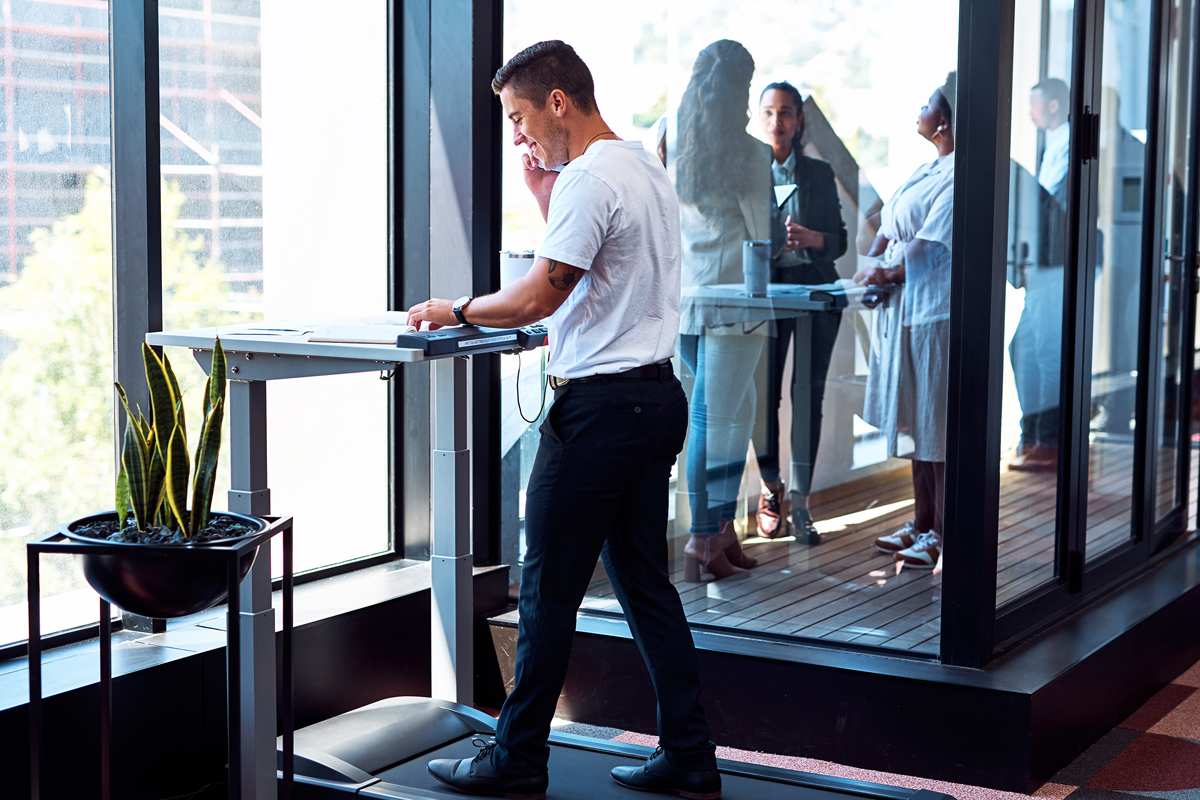TikTok fans are already aware that walking pads are a social media sensation. But the popular fitness trend is more than just a passing online fad – particularly for people with desk-bound jobs.
This low-impact fitness solution is a great way to incorporate more movement into your day, but it also comes with some safety risks. If you’re considering a walking pad, there are some important things to know before you take the first step.
What is a walking pad?
A walking pad is a small, lightweight treadmill that is foldable, portable, and compact enough to fit under a desk. It can be used at home or in the office with a standing or adjustable-height workstation.
Most walking pads typically lack the bells and whistles – and hefty price tag – you’ll find on a treadmill, like interactive displays, heart rate monitors, rails, adjustable inclines, or high-speed running capabilities. Some models do come with adjustable speeds or resistance, but they aren’t designed for running. Most walking pads max at around 5 miles per hour. (Think brisk walking pace.)
What are the benefits of walking pads?
Along with their space-saving design, affordability, and portability, walking pads offer a simple way to keep your body and mind in motion, especially if you’re seated most of the day. Benefits include:
- More movement: Prolonged sitting, whether at work or home, has been linked to various health issues, including cardiovascular disease, diabetes, stroke, depression, anxiety, and a whole lot of aches and pains. Incorporating sporadic activity is shown to reduce these health risks.
- Improved brain function and focus: Walking has been shown to enhance brain activity and mental clarity, making it easier to stay engaged and motivated.
- Reduced stress levels: Regular movement helps keep stress levels in check – even on the most hectic workdays.
- Improved mood and energy: Increased physical activity helps boost circulation and energy levels.
Health experts agree that walking pads are a great tool to enhance your exercise regimen on sedentary days, but they shouldn’t be a replacement for your regular fitness routine. And nothing can replace a walk outdoors. Time in nature and away from screens is especially beneficial for your mental and physical wellbeing.
What are the most common injuries associated with walking pads?
Although walking pads are generally safe when used properly, injuries can happen. Some common ones include:
- Joint strain: Prolonged use can cause repetitive strain, especially in the knees, feet, and ankles.
- Injuries from falls: There’s a risk of slips, trips, and falls, particularly if you’re distracted or when stepping off a walking pad.
- Ergonomic injuries: Poor posture or improperly adjusted desk height can lead to strain in the neck, back, wrists, or shoulders.
How can I safely use my walking pad?
If you’re ready to go the walking pad route, taking some simple precautions will help you stay safe and reap the benefits.
- Set it up safely: Place your walking pad on a flat, stable surface and allow plenty of room to move around it. Keep the area free of cords or other trip hazards.
- Make it ergonomically correct: Always use your walking pad with a standing workstation and make sure it is properly aligned with your desk, screen, and keyboard. Your eyes should be level with the top of the computer monitor.
- Get familiar with the equipment: Before you take your first step, learn your walking pad’s safety features and controls. Like treadmills, walking pads usually have a safety clip or emergency stop button. Don’t forget to check the weight capacity, as most walking pads are designed to accommodate up to 220 pounds.
- Wear the right shoes: Comfortable, supportive footwear designed for walking will help maintain proper body alignment and minimize joint strain. Avoid slippers, flip-flops, or walking barefoot.
- Start slow: Begin with short walks at a slow pace, gradually increasing your speed and duration. Sudden changes in speeds can lead to falls.
- Maintain proper posture: Keep your back straight, shoulders relaxed, and core engaged while walking.
- Stay hydrated: Drink plenty of water, especially when taking longer walks.
- Don’t make a run for it: Walking pads are not designed for running. Even light jogging is unsafe and could lead to injury. If running is your goal, stick with a treadmill or head outdoors.
If you have balance issues or a pre-existing medical condition, check with a health care provider before you make a walking pad part of your daily routine.
Indigo treats most minor illnesses and injuries
If you’ve decided to use a walking pad, you’re on the path to better health. But if you experience any discomfort, pain or injury, Indigo Urgent Care can help you get back on track.
Indigo treats a range of minor illnesses and injuries, including sprains and strains, minor fractures, bruises and more. We also provide Occupational Medicine services for job-related injuries.
Walk into one of our convenient locations, book a same-day or next-day appointment online, or schedule a face-to-face Indigo Virtual Care visit from the comfort of home or the office. An Indigo clinician will assess your symptoms and provide a prompt diagnosis and treatment plan. For added convenience, all of our locations also offer on-site digital x-ray services. And if you need a higher level of care, we’ll refer you to a specialist.
In-person and virtually, Indigo is open from 8 am to 8 pm, every day.


